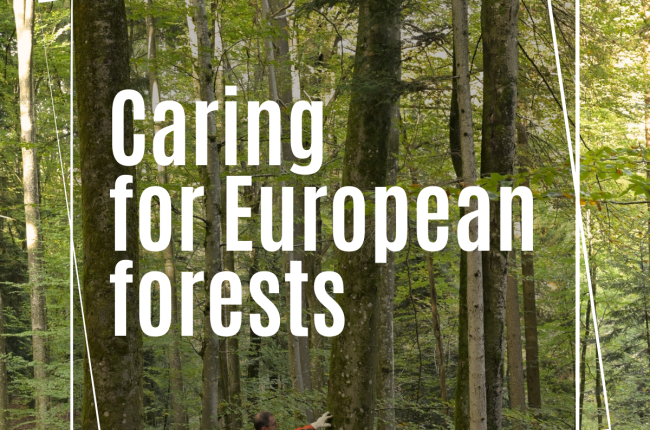
Representatives of the European forest owners and forest managers share their views on the launch of European Space Agency's (ESA) Bioeconomy Task Force
As representatives of the European forest owners and forest managers, we would like to congratulate ESA on the launch of the Space for Bioeconomy Task Force and share some insights from our sector.
Forests cover over 35% of Europe’s land area, they are owned and managed by different entities, whether public or private. With such vast area to care for, the support of well-designed remote sensing tools is undoubtedly of use. For those who work directly with forests, caring for their continued health and resilience are the foundations of what we understand by sustainable and multifunctional forest management.
Forests provide countless benefits and services to society at large, from timber and other forest products to carbon sequestration, water filtration, biodiversity conservation, and recreation. Managing forests responsibly is not only about safeguarding these resources for future generations but also ensuring that our operations are sustainable and economically viable in a long run.
Therefore, the opening of the Call for Space Solutions in Sustainable Forestry as part of the Task Force meets our members’ great interest. The proposal to harness space-based technologies to further support forestry offers significant opportunities but presents also challenges.
Opportunities
Earth observation technologies offer new tools to monitoring at big scale a growing number of parameters, such as the appearance and evolution of natural disasters and their risk factors. Thus, remote sensing in earth observations allow forest owners and managers to more effectively detect early signs of wildfires, disease, or pest infestation. Satellites equipped with thermal imaging technology could play a critical role in predicting, detecting, and monitoring wildfires, allowing us to respond more effectively and allocate resources where they are most needed.
Therefore, well-designed tools could support swift action to minimize damage, thus enhancing the long-term vitality of our forests.
Additionally, for forest owners having significant forest areas to monitor or living a long distance away from their forests, having reliable frequent and precise imagery could present some advantages.
While these opportunities are interesting, there are also challenges that we, as European forest owners and managers, need to carefully consider.
Challenges
One of the most immediate challenges to address is how to make space-based technologies feasible and affordable to forest owners and managers, particularly in smaller-scale operations. While large forest owners or manager organizations to large extent use earths observation systems or may have the resources to invest in advanced monitoring systems, small scale forest owners may struggle to afford these technologies.
Another challenge lies in managing the sheer volume of data that satellite technologies can provide. For many forest owners, interpreting complex satellite data might require specialized knowledge or training. It is critical that the solutions developed through this initiative are user-friendly and offer practical, actionable insights—not just raw data that could overwhelm those on the ground.
One also must remember that, while satellite services can greatly enhance decision-making, it is important to remember that they cannot serve as replacements for on-ground expertise. Forest management is a nuanced practice, and while data can inform our strategies, it must be integrated with scientific knowledge, regional interpretation and practical experience of owners and managers.
Finally, we must also consider the sensitivity, security and privacy of the data collected. Forest owners and managers must be assured the data collected about forest properties and operations therein will be used responsibly and securely.
Conclusions: European forest owners’ and managers’ insights on the Launch of the Task Force
The forest-based sector is increasingly recognizing that to meet the growing environmental and socio-economic demands placed on forests, we need to invest and innovate. Space-based solutions offer an opportunity to support an active forest management.
The ESA Sustainable Bioeconomy Task Force, with its focus on collaboration, innovation, and practical solutions, offers a platform that could contribute to answer some of the needs of European forest owners and managers.
Moreover, by supporting this Task Force, organizations representing forest owners and managers can help ensure that the solutions being developed are not just driven by technology providers but are aligned with the real-world needs and priorities. We want to be part of the conversation—helping to shape solutions that are both practical and scalable, benefiting not only large operations but also smaller forest owners who are equally committed to sustainable practices.
In conclusion, while space-based technologies present new opportunities and challenges, the overarching goal remains clear: to manage our forests in ways that balance environmental stewardship with economic sustainability. We are optimistic that the Call for Space Solutions in Sustainable Forestry, under the guidance of the Sustainable Bioeconomy Task Force, will help us achieve this balance.
That is why the representatives of forest owners and managers, are willing to support the launch of this initiative. We believe it has the potential to support forest management for the better, ensuring that our forests continue to thrive.
Signatories
CEPF – Confederation of European Forest Owners
Copa-Cogeca – European Farmers and Agri-Cooperatives
EUSTAFOR – European State Forest Association




